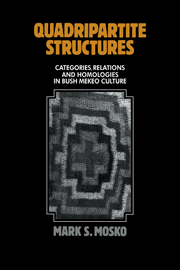Book contents
- Frontmatter
- Contents
- List of figures, tables, and maps
- Preface
- 1 Introduction: the problem and the people
- 2 Between village and bush
- 3 Body and cosmos
- 4 Sex, procreation, and menstruation
- 5 Male and female
- 6 Kin, clan, and connubium
- 7 Feasts of death (i): de-conception and re-conception
- 8 Feasts of death (ii): the sons of Akaisa
- 9 Tikopia and the Trobriands
- 10 Conclusions: indigenous categories, cultural wholes, and historical process
- Appendixes
- Notes
- Bibliography
- Index
8 - Feasts of death (ii): the sons of Akaisa
Published online by Cambridge University Press: 04 August 2010
- Frontmatter
- Contents
- List of figures, tables, and maps
- Preface
- 1 Introduction: the problem and the people
- 2 Between village and bush
- 3 Body and cosmos
- 4 Sex, procreation, and menstruation
- 5 Male and female
- 6 Kin, clan, and connubium
- 7 Feasts of death (i): de-conception and re-conception
- 8 Feasts of death (ii): the sons of Akaisa
- 9 Tikopia and the Trobriands
- 10 Conclusions: indigenous categories, cultural wholes, and historical process
- Appendixes
- Notes
- Bibliography
- Index
Summary
It has taken me this long in my interpreting of Bush Mekeo death and mourning ritual to address the significance of the roles played by peace chiefs specifically at death feasts and by Akaisa Men generally in the total culture. Also, I have not as yet closely examined the definitive element of the complete death-feast pange prestation – the ikufuka meat. This chapter will be devoted to analyzing these issues, for, as I will presently show, they are not only intimately connected with one another, but they relate directly to the culture hero Akaisa and thus involve the most central mythical symbols of all Bush Mekeo culture. Furthermore, the characteristic structure of bisected dualities will become evident in this context as in the others I have discussed.
It will be remembered that ikufuka consists of the intact carcass of a dog and iungefanga (a strip of backskin and pieces of liver, stomach, and small intestine from a village pig). At final mortuary feasts, owning peace chiefs give ikufuka to each of the kofuapie peace chiefs (including their friends) and peace sorcerers of the tribe. Because senior and junior peace chiefs of the same clan ideally make their feasts together, the senior peace chief gives ikufuka meat to senior kofuapie peace chiefs and peace sorcerers, and the junior peace chief to junior kofuapie peace chiefs and peace sorcerers. Kofuapie peace chiefs of the same status level, whether they are friend or nonfriend, should return identical quantities of ikufuka meat when they make their own feasts. Ikufuka is thus precisely reciprocal between kofuapie peace chiefs and, through them, their peace sorcerers.
- Type
- Chapter
- Information
- Quadripartite StructuresCategories, Relations and Homologies in Bush Mekeo Culture, pp. 182 - 199Publisher: Cambridge University PressPrint publication year: 1985



